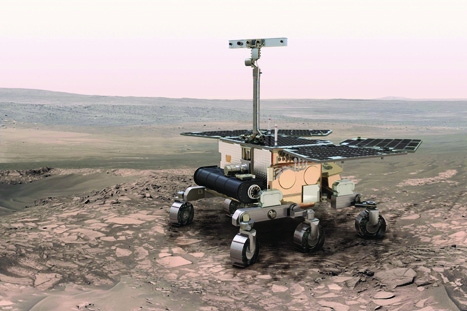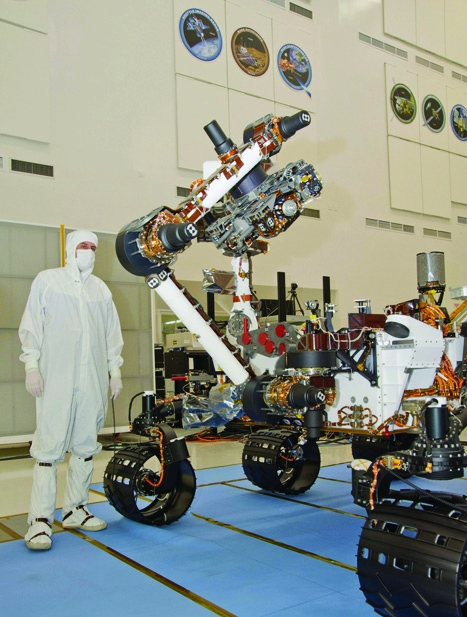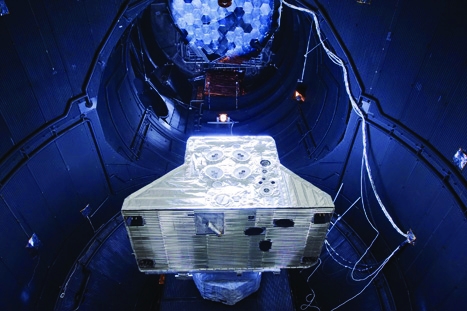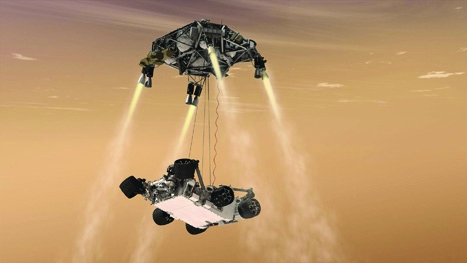If you look up on a clear evening at the moment, the Solar System reaches out and grabs you. Venus and Jupiter, close together in the west, are the brightest objects in the sky, Venus brilliant enough to leave an after-image when you look away. Turn your back on these two and look up a bit, and you can see Mars, its red colour clearly visible. If you’re lucky and you time it right, you can even glimpse fainter Mercury early in the evening and Saturn later on.
What you can’t see, of course, are the dozens of spacecraft, emissaries and probes, taking photos, monitoring radiation, gathering data and sending it back, expanding our knowledge of the Solar System and looking beyond out into the universe.
But our exploration of the planets may be in trouble. With many of the major countries involved in space currently in the midst of financial crisis, funding for these expensive projects is under scrutiny. It must compete with other areas of government funding, and the enormous cost of launching spacecraft to other planets — however fascinating and tempting the scientific goals — means that they are an obvious target for savings.

Under particular scrutiny at the moment is ExoMars, the planned 2018 mission to send a rover to Mars to search for molecules that may indicate the presence of past life. Starting as a European Space Agency (ESA) mission, ExoMars became what was hoped to be a trailblazer for cross-agency collaboration when NASA came on board in 2009, providing a launch vehicle and combining the project into an ambitious two-rover mission, sending the European ExoMars rover along with a NASA rover called Max-C, which would cache rocks as part of a future sample return mission.
“Is it the end of the road for NASA collaboration? No. I think — I hope — it’s a bump in the road”David Parker, UK Space Agency
Too ambitious, it turned out. Budgetary concerns led to the cancellation of Max-C last April, with the proposal that a single rover — larger than either of the original two — would be built to combine the functions of Max-C and the ExoMars rover; it would carry the ExoMars scientific payload and have the ability to cache rocks. NASA would provide the launch vehicle and the Skycrane landing system, the first of which is currently on its way to Mars where it will land the Curiosity rover (see panel), while ESA would build the rover. EADS Astrium’s UK facility in Stevenage, which had been chosen to build the European rover, started to gear up for the enhanced design.

But doubt still surrounded the mission, and last month NASA announced that it was terminating its participation in ExoMars, to the shock of the partners at ESA, the UK Space Agency and Astrium, as well as the main NASA participant, the Jet Propulsion Laboratory (JPL) in Pasadena, which is the agency’s centre for planetary exploration projects. Although the JPL is buzzing with anticipation for the landing of Curiosity in early August, director Charles Elachi said there was much disappointment at the pull-out, especially as the ExoMars mission was an integral part of NASA’s flagship goal for this decade: the return of geological samples from Mars.
‘We at JPL still believe collaboration with Europe — and elsewhere — is critical,’ Elachi told The Engineer. ‘But while it has the great advantage of allowing us to expand the scope of missions, it has the disadvantage of being more vulnerable to schedules and the political and budgetary outlook. Everyone has to agree to put the money in at the appropriate time.’ He said that it was merely this problem of scheduling that scuppered the joint ExoMars mission. ‘ExoMars is 2016 and 2018, and in this period — which requires funding now — the economic situation in the US meant that we couldn’t come up with appropriate funding. It isn’t a fundamental change in policy or philosophy; it’s just a matter of timing. We’re looking at later missions, but I’m sure that NASA will be open to collaboration in the future.’
Elachi neatly summed up why exploring the Solar System is important for society: ‘Exploration is something that uplifts the spirit of young people and the general population, and that applies to economic activity as well, expanding that spirit of curiosity in your everyday life; it creates an atmosphere of initiative.’
Moreover, of course, the technological payback is immensely valuable. ‘The basic physics of the code in your cellphone was done by people at the JPL in the 1960s and 1970s to communicate with our spacecraft,’ he said. ‘Infrared cameras used in surgery were based on infrared detectors developed for our telescopes. The robot arms used in remote surgery are effectively the same as the arms on the Mars rovers.
You could argue that these technologies would have been developed anyway, as part of commercial research. But I believe the way you do innovation is to take a bunch of very bright people and give them some very challenging and exciting problem that seems almost impossible, so they have to invent how to make it possible. That’s the benefit of space exploration: it’s the one that’s the most engaging for imaginative people. It’s bold and exciting and people get very inspired to work on it. Achieving what seems impossible is such a powerful draw.’
“I believe the way you do innovation is to take a bunch of bright people and give them a challenging problem that seems almost impossible”Charles Elachi, NASA JPL
A Mars mission can be launched every other year, and the planet moves closer and further away from the Earth in a 14-year cycle. The next time it will be close enough for a major landing mission is in 2018-20, and NASA is in the planning phase for that opportunity. Elachi doesn’t rule out collaboration with ESA and other agencies for a further mission and pointed out that NASA can move fast when it needs to. ‘We only had four years to plan the Spirit and Curiosity landings in 2004, and they’ve been amazingly successful,’ he said.
But the increasing reality of planetary science is that it can only be done with cross-agency collaboration, which is why NASA’s withdrawal from ExoMars has caused such alarm. ‘I think everyone saw that as the beginning of a fruitful relationship for the future, and indeed the JPL saw it as an integral part of the three-part roadmap for Mars sample return,’ said Mark Roe, EADS Astrium’s ExoMars project manager. ‘The ExoMars rover would cache rocks, then there would be an orbiter with a return capsule and finally a “fetch rover” with a launcher that would send the samples back to the orbiter. The pull-out from NASA sets that schedule back; how long is a guessing game, but my guess is 10 years. The Mars community is smarting at the moment.’
David Parker, science director of the UK Space Agency, believes NASA has been faced with a very difficult decision. ‘They’ve had a cost overrun on the James Webb Space Telescope, and their budget is basically flat cash so they’ve had to make savings somewhere. I don’t fully understand the rationale behind why the Mars programme has been identified as the place to find the savings, but from our point of view it’s extremely frustrating that the thing that’s been sacrificed is the one that’s so strongly about co-operation across the Atlantic.’
However, Parker hopes the pull-out from ExoMars is an exception in the trend of cross-agency collaboration. ‘ESA is getting ready to start the science on the Solar Orbiter mission, which is an ESA-led mission with strong involvement from the UK — the spacecraft will be built here. That has NASA involvement; they’re providing a launcher.’
In the planetary field, the BepiColombo mission to explore Mercury is progressing well towards its launch in 2015. ‘Two spacecraft are being sent towards Mercury together; one is European, the other Japanese,’ Parker said. ‘It’s probably a €1.4bn- €1.5bn project, combined, and that’s well beyond what either agency could afford on its own.’ Similarly, an astrophysics project to detect gravity waves is being pursued as an ESA-NASA mission, he added; and the James Webb telescope itself, the possible reason for the budgetary tightness, is a cross-agency project to be launched by an Ariane 5 and carrying European systems, including a UK-made infrared detector.

Looking ahead, the most exciting targets for research in the Solar System are the moons of the gas giants. Europa, a moon of Jupiter, and one of Saturn’s satellites, Enceladus, both have ice surfaces overlaying oceans of liquid water, while Saturn’s largest moon, Titan, has an intriguing atmosphere where methane fills a similar role to water on Earth, forming clouds and ‘raining’ into bodies of liquid on the surface. ‘If you wanted to do a mission to orbit Europa, and maybe land and drill there to reach the ocean, that’s a colossally expensive mission and would definitely need international collaboration,’ said Parker.
For ExoMars, meanwhile, the project is continuing. According to Parker, the rover could be launched atop a Russian Proton rocket — talks are under way with Russian space agency Roscosmos to see whether this would be possible — or from Europe’s own Ariane 5 heavy-lift vehicle. ‘The project team remains focused on delivering this mission in 2018,’ said Roe. ‘The Skycrane lander system is a particular loss, but in the frame of the ESA 2016 Mars mission [to send a communications orbiter and experimental instrumented lander] ESA is developing an entry descent and landing technology with autonomous rockets and descent systems, and the plan is to use the technology that we prove in 2016, scaled up, to land the rover in 2018.’ This system might use vented airbags, similar to those used to land NASA’s Spirit and Opportunity rovers, or crushable foam structures to absorb the shock of landing, he said.
“The plan is to use the technology that we prove in 2016, scaled up, to land the rover in 2018”Mark Roe, ExoMars director, EADS Astrium
Test are currently under way on a system that uses the guidance rockets from ESA’s ‘space truck’, the automated transfer vehicle that resupplies and boosts the International Space Station, as a landing retro-rocket for a planned European lunar lander. Although the US and Russia have had such landing systems for decades, this will be a first for Europe, and Parker thinks this might presage a new trend. ‘I suspect that some [ESA] member states will take the political message that having an independent capability is a good thing,’ he said.
Previously, the thinking was that if capability existed elsewhere, then developing what was effectively duplicate technology was a waste of resources. But the shock of NASA’s withdrawal from ExoMars is still stark. ‘Do I think this is the end of the road for NASA collaboration? No,’ Parker said. ‘I think — I hope — that it’s a bump in the road. I don’t know how we’re going to get around it yet.’
Roe is rueful. ‘Much has been said about the readiness of the agencies to collaborate,’ he said. ‘We tried to push the collaboration very quickly but I suspect in ExoMars we were trying to push that too far, too quickly. I think we’ll see in the background the discussions that are ongoing on how to collaborate. They need to do it — that’s for certain.’
In depth
Looking for life on mars
In August, the Curiosity rover will become the largest payload that anyone has ever attempted to land on the red planet

’Put it in your calendars,’ Charles Elachi said. ‘Monday 6 August at 18:00, 30 minutes and 13 seconds, London time.’ That’s when the Mars Science Laboratory, also known as the Curiosity rover, will touch down on Mars in a region called the Gale Crater.
Roughly the size of a Mini Cooper and weighing 900kg, Curiosity is the largest payload that anyone’s attempted to land on Mars. Its task is to climb the side of a Martian mountain where there is evidence from orbital surveying of layered rocks, possibly deposited by a long-vanished ocean. It is equipped with a laser to vaporise the surface of rocks, a drill mounted on a robotic arm to extract samples and ovens to treat the samples so that on-board mass spectrometry and X-ray spectroscopy can examine the samples to determine the composition of the Martian minerals and, maybe, detect for the first time carbon-rich compounds that could be signs of life, either in the past or even currently existing.
But getting it onto the surface involves what Elachi calls ‘six minutes of terror’. There are some 90 systems on the craft that have to work, in sequence, to take the rover from the edge of Mars’s atmosphere to the surface. ‘To get Curiosity to the target area, the precision required is equivalent to me hitting a golf ball from a course in Los Angeles and getting it into a hole on a course in St Andrews, Scotland,’ Elachi said; moreover, the target itself is moving at high speed.
Then there’s the sheer speed of the spacecraft. ‘It’s roughly a one-tonne rover, and with the heatshield and carrier it’s roughly three tonnes of mass, coming in at 12,000mph [19,000km/h] — that’s the equivalent of 25 high-speed trains going at full speed. That’s the amount of energy we have to dissipate in six minutes.’
Some 90 per cent of the energy will be dissipated by the spacecraft’s heat shield, and once this is jettisoned a parachute is deployed to brake 90 per cent of the remaining speed. The craft will then drop the lander on its carrier: Skycrane. This will fire retro-rockets to bring it to a hover above the Martian surface. Then the rover’s wheels will rotate from their stowed configuration to their functional position while a winch lowers the rover on a cable. Once the wheels touch the ground, the cable will disengage and the carrier will crash-land some distance away. The system has been tested in simulation and in drops from helicopters but has never been used in a planetary landing, and fingers will be firmly crossed at mission control in Pasadena.

Curiosity itself is nuclear powered, with a plutonium radiothermal generator system to allow the rover to operate day and night; it allows the rover to carry a larger payload, Elachi said. The mission profile is for two years, but could well last longer. ‘Spirit and Opportunity were supposed to last for 90 days, but one is still working seven years later,’ he added. ‘It’d be great to get Curiosity to the top of the mountain and look down over the landscape, but that would be a significant extension of the mission. We do test all the mechanical systems for three times as long as the proposed mission, though.’










Comment: The UK is closer to deindustrialisation than reindustrialisation
"..have been years in the making" and are embedded in the actors - thus making it difficult for UK industry to move on and develop and apply...